Electrical connector


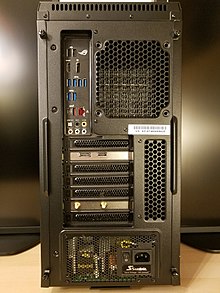
Components of anelectrical circuitareelectrically connectedif anelectric currentcan run between them through anelectrical conductor.Anelectrical connectoris anelectromechanicaldevice used to create an electrical connection between parts of an electrical circuit, or between different electrical circuits, thereby joining them into a larger circuit.[1]
The connection may be removable (as for portable equipment), require a tool for assembly and removal, or serve as a permanent electrical joint between two points.[2]Anadaptercan be used to join dissimilar connectors. Most electrical connectors have agender– i.e. the male component, called aplug,connects to the female component, orsocket.
Thousands of configurations of connectors are manufactured forpower,data,andaudiovisualapplications.[3]Electrical connectors can be divided into four basic categories, differentiated by their function:[4]
- inlineorcableconnectors permanently attached to a cable, so it can be plugged into anotherterminal(either a stationary instrument or another cable)[5]
- Chassisorpanelconnectors permanently attached to a piece of equipment so users can connect a cable to a stationary device
- PCB mountconnectors soldered to aprinted circuit board,providing a point forcableorwireattachment.[6]: 56 (e.g.pin headers,screw terminals,board-to-board connectors)
- Spliceorbuttconnectors (primarilyinsulation displacement connectors) that permanently join two lengths of wire or cable
In computing, electrical connectors are considered a physical interface and constitute part of thephysical layerin theOSI modelof networking.
Physical construction
[edit]In addition to the classes mentioned above, connectors are characterised by theirpinout,method of connection,materials, size,contact resistance,insulation,mechanical durability,ingress protection,lifetime(number of cycles), and ease of use.
It is usually desirable for a connector to be easy to identify visually, rapid to assemble, inexpensive, and require only simple tooling. In some cases an equipment manufacturer might choose a connector specifically because it isnotcompatible with those from other sources, allowing control of what may be connected. No single connector has all the ideal properties for every application; the proliferation of types is a result of the diverse yet specific requirements of manufacturers.[7]: 6
Materials
[edit]Electrical connectors essentially consist of two classes of materials: conductors and insulators. Properties important to conductor materials are contact resistance,conductivity,mechanical strength,formability,andresilience.[8]Insulators must have a highelectrical resistance,withstand high temperatures, and be easy to manufacture for a precise fit
Electrodesin connectors are usually made ofcopper alloys,due to their good conductivity andmalleability.[7]: 15 Alternatives includebrass,phosphor bronze,andberyllium copper.The base electrode metal is often coated with another inert metal such asgold,nickel,ortin.[8]The use of a coating material with good conductivity, mechanical robustness and corrosion resistance helps to reduce the influence of passivating oxide layers and surface adsorbates, which limit metal-to-metal contact patches and contribute to contact resistance. For example, copper alloys have favorable mechanical properties for electrodes, but are hard to solder and prone to corrosion. Thus, copper pins are usually coated with gold to alleviate these pitfalls, especially for analog signals and high-reliability applications.[9][10]
Contactcarriersthat hold the parts of a connector together are usually made of plastic, due to its insulating properties.Housingsorbackshellscan be made of molded plastic and metal.[7]: 15 Connector bodies for high-temperature use, such asthermocouplesor associated with largeincandescent lamps,may be made of fired ceramic material.
Failure modes
[edit]The majority of connector failures result in intermittent connections or open contacts:[11][12]
| Failure mode | Relative probability |
|---|---|
| Open circuit | 61% |
| Poor contact | 23% |
| Short circuit | 16% |
Connectors are purelypassivecomponents – that is, they do not enhance the function of a circuit – so connectors should affect the function of a circuit as little as possible. Insecure mounting of connectors (primarily chassis-mounted) can contribute significantly to the risk of failure, especially when subjected to extreme shock or vibration.[11]Other causes of failure are connectors inadequately rated for the applied current and voltage, connectors with inadequate ingress protection, and threadedbackshellsthat are worn or damaged.
High temperatures can also cause failure in connectors, resulting in an "avalanche" of failures – ambient temperature increases, leading to a decrease in insulation resistance and increase in conductor resistance; this increase generates more heat, and the cycle repeats.[11]
Fretting(so-calleddynamic corrosion) is a commonfailure modein electrical connectors that have not been specifically designed to prevent it, especially in those that are frequently mated and de-mated.[13]Surfacecorrosionis a risk for many metal parts in connectors, and can cause contacts to form a thin surface layer that increases resistance, thus contributing to heat buildup and intermittent connections.[14]However, remating or reseating a connector can alleviate the issue of surface corrosion, since each cycle scrapes a microscopic layer off the surface of the contact(s), exposing a fresh, unoxidised surface.
Circular connectors
[edit]Many connectors used for industrial and high-reliability applications are circular in cross section, with a cylindrical housing and circular contact interface geometries. This is in contrast to the rectangular design of some connectors, e.g.USBorblade connectors.They are commonly used for easier engagement and disengagement, tight environmental sealing, and rugged mechanical performance.[15]They are widely used in military, aerospace, industrial machinery, and rail, whereMIL-DTL-5015andMIL-DTL-38999are commonly specified. Fields such assound engineeringandradio communicationalso use circular connectors, such asXLRandBNC.AC power plugsare also commonly circular, for example,Schukoplugs andIEC 60309.

TheM12 connector,specified in IEC 61076-2-101, is a circular electrical plug/receptacle pair with 12mm OD mating threads, used inNMEA 2000,DeviceNet,IO-Link,some kinds ofIndustrial Ethernet,etc.[16][17]
A disadvantage of the circular design is its inefficient use of panel space when used in arrays, when compared to rectangular connectors.
Circular connectors commonly usebackshells,which provide physical and electromagnetic protection, whilst sometimes also providing a method for locking the connector into a receptacle.[18]In some cases, this backshell provides ahermetic seal,or some degree ofingress protection,through the use ofgrommets,O-rings,orpotting.[15]
Hybrid connectors
[edit]Hybrid connectors allow the intermixing of many connector types, usually by way of a housing with inserts.[19]These housings may also allow intermixing of electrical and non-electrical interfaces, examples of the latter being pneumatic line connectors, andoptical fiber connectors.Because hybrid connectors are modular in nature, they tend to simplify assembly, repair, and future modifications. They also allow the creation of composite cable assemblies that can reduce equipment installation time by reducing the number of individual cable and connector assemblies.
Mechanical features
[edit]Pin sequence
[edit]Some connectors are designed such that certain pins make contact before others when inserted, and break first on disconnection.[1]This is often used inpower connectorsto protect equipment, e.g. connectingsafety groundfirst. It is also employed for digital signals, as a method to sequence connections properly inhot swapping.
Keying
[edit]Many connectors arekeyedwith some mechanical component (sometimes called akeyway), which prevents mating in an incorrect orientation.[20]This can be used to prevent mechanical damage to connectors, from being jammed in at the wrong angle or into the wrong connector, or to prevent incompatible or dangerous electrical connections, such as plugging an audio cable into a power outlet.[1]Keying also prevents otherwise symmetrical connectors from being connected in the wrong orientation orpolarity.Keying is particularly important for situations where there are many similar connectors, such as in signal electronics.[7]: 26 For instance,XLR connectorshave a notch to ensure proper orientation, whileMini-DINplugs have a plastic projection that fits into a corresponding hole in the socket (they also have a notched metal skirt to provide secondary keying).[21]
Locking mechanisms
[edit]Some connector housings are designed with locking mechanisms to prevent inadvertent disconnection or poor environmental sealing.[1]Locking mechanism designs include locking levers of various sorts,jackscrews,screw-in shells,push-pull connector,and toggle orbayonetsystems. Some connectors, particularly those with large numbers of contacts, require high forces to connect and disconnect. Locking levers and jackscrews and screw-in shells for such connectors frequently serve both to retain the connector when connected and to provide the force needed for connection and disconnection. Depending on application requirements, housings with locking mechanisms may be tested under various environmental simulations that include physical shock and vibration, water spray, dust, etc. to ensure the integrity of the electrical connection and housing seals.
Backshells
[edit]Backshellsare a common accessory for industrial and high-reliability connectors, especiallycircular connectors.[18]Backshells typically protect the connector and/or cable from environmental or mechanical stress, or shield it fromelectromagnetic interference.[22]Many types of backshells are available for different purposes, including various sizes, shapes, materials, and levels of protection. Backshells usually lock onto the cable with a clamp or moulded boot, and may be threaded for attachment to a mating receptacle.[23]Backshells for military and aerospace use are regulated by SAE AS85049 within the USA.[24]
Hyperboloid contacts
[edit]To deliver ensured signal stability in extreme environments, traditional pin and socket design may become inadequate. Hyperboloid contacts are designed to withstand more extreme physical demands, such as vibration and shock.[20]They also require around 40% less insertion force[25]– as low as 0.3 newtons (1 ozf) per contact,[26]– which extends the lifespan, and in some cases offers an alternative tozero insertion forceconnectors.[27][25]
In a connector with hyperboloid contacts, each female contact has several equally spaced longitudinal wires twisted into a hyperbolic shape. These wires are highly resilient to strain, but still somewhat elastic, hence they essentially function as linear springs.[28][29]As the male pin is inserted, axial wires in the socket half are deflected, wrapping themselves around the pin to provide a number of contact points. The internal wires that form the hyperboloid structure are usually anchored at each end by bending the tip into a groove or notch in the housing.[30]
Whilst hyperboloid contacts may be the only option to make a reliable connection in some circumstances, they have the disadvantage of taking up greater volume in a connector, which can cause problems for high-density connectors.[25]They are also significantly more expensive than traditional pin and socket contacts, which has limited their uptake since their invention in the 1920s by Wilhelm Harold Frederick.[31]In the 1950s, Francois Bonhomme popularised hyperboloid contacts with his "Hypertac" connector, which was later acquired bySmiths Group.During the following decades, the connectors steadily gained popularity, and are still used for medical, industrial, military, aerospace, and rail applications (particularly trains in Europe).[28]
Pogo pins
[edit]
Pogo pinorspring loadedconnectors are commonly used in consumer and industrial products, where mechanical resilience and ease of use are priorities.[32]The connector consists of a barrel, a spring, and a plunger. They are in applications such as theMagSafeconnector where a quick disconnect is desired for safety. Because they rely on spring pressure, not friction, they can be more durable and less damaging than traditional pin and socket design, leading to their use inin-circuit testing.[33]
Crown spring connectors
[edit]
Crown spring connectors are commonly used for higher current flows and industrial applications. They have a high number of contact points, which provides a more electrically reliable connection than traditional pin and socket connectors.[34]
Methods of connection
[edit]Whilst technically inaccurate, electrical connectors can be viewed as a type of adapter to convert between two connection methods, which are permanently connected at one end and (usually) detachable at the other end.[7]: 40 By definition, each end of this "adapter" has a different connection method – e.g. the solder tabs on a malephone connector,and the male phone connector itself.[3]In this example, the solder tabs connected to the cable represent the permanent connection, whilst the male connector portion interfaces with a female socket forming a detachable connection.
There are many ways of applying a connector to a cable or device. Some of these methods can be accomplished without specialized tools. Other methods, while requiring a special tool, can assemble connectors much faster and more reliably, and make repairs easier.
The number of times a connector can connect and disconnect with its counterpart while meeting all its specifications is termed asmating cyclesand is an indirect measure of connector lifespan. The material used for connector contact, plating type and thickness is a major factor that determines the mating cycles.[35]
Plug and socket connectors
[edit]Plug and socket connectors are usually made up of a maleplug(typically pin contacts) and a femalesocket(typically receptacle contacts). Often, but not always, sockets are permanently fixed to a device as in a chassis connector,and plugs are attached to a cable.
Plugs generally have one or more pins or prongs that are inserted into openings in the mating socket. The connection between the mating metal parts must be sufficiently tight to make a good electrical connection and complete the circuit. An alternative type of plug and socket connection useshyperboloid contacts,which makes a more reliable electrical connection. When working with multi-pin connectors, it is helpful to have apinoutdiagram to identify the wire or circuit node connected to each pin.
Some connector styles may combine pin and socket connection types in a single unit, referred to as ahermaphroditic connector.[6]: 56 These connectors includes mating with both male and female aspects, involving complementary paired identical parts each containing both protrusions and indentations. These mating surfaces are mounted into identical fittings that freely mate with any other, without regard for gender (provided that the size and type match).
Sometimes both ends of a cable are terminated with the same gender of connector, as in manyEthernetpatch cables. In other applications the two ends are terminated differently, either with male and female of the same connector (as in anextension cord), or with incompatible connectors, which is sometimes called anadaptercable.
Plugs and sockets are widely used in various connector systems including blade connectors,breadboards,XLR connectors,car power outlets,banana connectors,andphone connectors.
Jacks and plugs
[edit]
Ajackis a connector that installs on the surface of a bulkhead or enclosure, and mates with its reciprocal, theplug.[36]According to theAmerican Society of Mechanical Engineers,[37]the stationary (more fixed) connector of a pair is classified as ajack(denoted J), usually attached to a piece of equipment as in a chassis-mount or panel-mount connector. The movable (less fixed) connector is classified as aplug(denoted P),[37]designed to attach to a wire, cable or removable electrical assembly.[38]This convention is currently defined in ASME Y14.44-2008, which supersedesIEEE 200-1975,which in turn derives from the long-withdrawn MIL-STD-16 (from the 1950s), highlighting the heritage of this connector naming convention.[36]IEEE 315-1975 works alongside ASME Y14.44-2008 to define jacks and plugs.
The termjackoccurs in several related terms:
- Theregistered jackormodular jackin RJ11, RJ45 and other similar connectors used fortelecommunicationandcomputer networking
- Thetelephone jackof manualtelephone switchboards,which is the socket fitting the original1⁄4inch (6.35 mm)telephone plug
- The1⁄4inch (6.35 mm)phone jackcommon to many electronic applications in various configurations, sometimes referred to as aheadphone jack
- TheRCA jack,also known as aphono jack,common to consumer audiovisual electronics
- TheEIAJ jackfor consumer appliances requiring a power supply of less than 18.0 volts
Crimp-on connectors
[edit]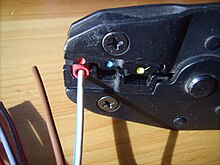
Crimped connectorsare a type of solderless connection, using mechanical friction and uniform deformation to secure a connector to a pre-stripped wire (usually stranded).[1]Crimping is used inspliceconnectors, crimped multipin plugs and sockets, and crimped coaxial connectors. Crimping usually requires a specialised crimping tool, but the connectors are quick and easy to install and are a common alternative to solder connections or insulation displacement connectors. Effective crimp connections deform the metal of the connector past itsyield pointso that the compressed wire causestensionin the surrounding connector, and these forces counter each other to create a high degree ofstatic friction.Due to the elastic element in crimped connections, they are highly resistant tovibrationandthermal shock.[39]
Crimped contacts are permanent (i.e. the connectors and wire ends cannot be reused).[40]
Crimpedplug-and-socket connectors can be classified asrear releaseorfront release.This relates to the side of the connector where the pins are anchored:[20]
- Front release contactsare released from the front (contact side) of the connector, and removed from the rear. The removal tool engages with the front portion of the contact and pushes it through to the back of the connector.
- Rear release contactsare released and removed from the rear (wire side) of the connector. The removal tool releases the contacts from the rear and pulls the contact out of the retainer.
Soldered connectors
[edit]Many plug and socket connectors are attached to a wire or cable bysolderingconductors to electrodes on the back of the connector. Soldered joints in connectors are robust and reliable if executed correctly, but are usually slower to make than crimped connections.[1]When wires are to be soldered to the back of a connector, abackshellis often used to protect the connection and add strain relief. Metalsolder bucketsorsolder cupsare provided, which consist of a cylindrical cavity that an installer fills with solder before inserting the wire.[41]
When creating soldered connections, it is possible to melt thedielectricbetween pins or wires. This can cause problems because the thermal conductivity of metals causes heat to quickly distribute through the cable and connector, and when this heat melts plastic dielectric, it can causeshort circuitsor "flared" (conical) insulation.[40]Solder joints are also more prone to mechanical failure than crimped joints when subjected to vibration and compression.[42]
Insulation-displacement connectors
[edit]Since stripping insulation from wires is time-consuming, many connectors intended for rapid assembly useinsulation-displacement connectorswhich cut the insulation as the wire is inserted.[1]These generally take the form of a fork-shaped opening in the terminal, into which the insulated wire is pressed, which cut through the insulation to contact the conductor. To make these connections reliably on a production line, special tools accurately control the forces applied during assembly. On small scales, these tools tend to cost more than tools for crimped connections.
Insulation displacement connectors are usually used with small conductors for signal purposes and at low voltage. Power conductors carrying more than a few amperes are more reliably terminated with other means, though "hot tap" press-on connectors find some use in automotive applications for additions to existing wiring.
A common example is the multi-conductor flat ribbon cable used in computer disk drives; to terminate each of the many (approximately 40) wires individually would be slow and error-prone, but an insulation displacement connector can terminate all the wires in a single action. Another very common use is so-calledpunch-down blocksused for terminatingunshielded twisted pairwiring.
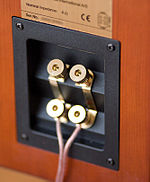
Binding posts
[edit]Binding posts are a single-wire connection method, where stripped wire is screwed or clamped to a metal electrode. Such connectors are frequently used inelectronic test equipmentand audio. Many binding posts also accept abanana plug.
Screw terminals
[edit]Screw connections are frequently used for semi-permanent wiring and connections inside devices, due to their simple but reliable construction. The basic principle of all screw terminals involves the tip of a bolt clamping onto a stripped conductor. They can be used to join multiple conductors,[43]to connect wires to aprinted circuit board,or to terminate a cable into a plug or socket.[7]: 50 The clamping screw may act in the longitudinal axis (parallel to the wire) or the transverse axis (perpendicular to the wire), or both. Some disadvantages are that connecting wires is more difficult than simply plugging in a cable, and screw terminals are generally not very well protected from contact with persons or foreign conducting materials.
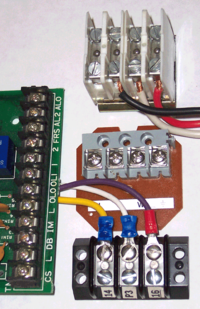
Terminal blocks(also called terminalboardsorstrips) provide a convenient means of connectingindividualelectrical wires without a splice or physically joining the ends. Since terminal blocks are readily available for a wide range of wire sizes and terminal quantity, they are one of the most flexible types of electrical connector available. One type of terminal block accepts wires that are prepared only by stripping a short length ofinsulationfrom the end. Another type, often calledbarrier strips,accepts wires that have ring or spade terminallugscrimped onto the wires.
Printed circuit board(PCB) mountedscrew terminalslet individual wires connect to a PCB through leads soldered to the board.
Ring and spade connectors
[edit]
The connectors in the top row of the image are known asring terminalsandspade terminals(sometimes called fork or split ring terminals). Electrical contact is made by the flat surface of the ring or spade, while mechanically they are attached by passing a screw or bolt through them. The spade terminal form factor facilitates connections since the screw or bolt can be left partially screwed in as the spade terminal is removed or attached. Their sizes can be determined by thegaugeof the conducting wire, and the interior and exterior diameters.
In the case of insulated crimp connectors, the crimped area lies under an insulating sleeve through which the pressing force acts. During crimping, the extended end of this insulating sleeve is simultaneously pressed around the insulated area of the cable, creating strain relief. The insulating sleeve of insulated connectors has a color that indicates the wire'scross-section area.Colors are standardized according to DIN 46245:
- Red for cross-section areas from 0.5 to 1 mm²
- Blue for cross-section areas from 1.5 to 2.5 mm²
- Yellow for cross-section areas over 4 to 6 mm²
Blade connectors
[edit]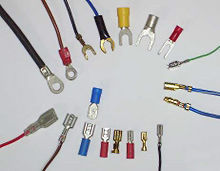
Ablade connectoris a type of single wire, plug-and-socket connection device using a flat conductive blade (plug) that is inserted into a receptacle. Wires are typically attached to male or female blade connector terminals by eithercrimpingorsoldering.Insulated and uninsulated varieties are available. In some cases the blade is an integral manufactured part of a component (such as a switch or a speaker unit), and the reciprocal connector terminal is pushed onto the device's connector terminal.
Other connection methods
[edit]- Alligator and Crocodile clips– conductive clamps used for temporary connections, e.g.jumper cables
- Board to board connectors– e.g.card-edge connectorsorFPGA mezzanine connectors
- Twist-on wire connectors(e.g. wire nuts) – used inlow-voltagepower circuits for wires up to about 10 AWG
- Wire wrapping– used in older circuit boards
See also
[edit]- Adapter
- Bent pin analysis
- Cable gland
- Electrical contact
- Electrical network
- Electrical termination
- Gender of connectors and fasteners
- InCa3D
- Lightbulb socket
- Line splice
- Potheadfor a termination on a high voltage electric power cable
- Tee connector
- Tube socket
- Twist-on wire connector
Connectors
[edit]- AC power plugs and sockets
- Audio and video interfaces and connectors
- Banana connector
- Battery holder
- Battery terminal
- Coaxial power connector
- Computer port (hardware)
- Crocodile clip
- DC connector
- DIN connector
- Dock connector
- D-sub connectors
- Edge connector
- Elastomeric connector
- IEC appliance couplers (IEC 60320)
- JST connector
- Mini-DIN connector
- Optical fiber connector
- Phone connector (audio)
- Pin header
- RCA connector
- RJ-XXconnector
- Flexible electronics
References
[edit]- ^abcdefg"Electrical Connectors Information".Engineering360.IEEE GlobalSpec.Retrieved30 June2019.
- ^Mroczkowski, Robert S. (1998). "Ch 1".Electrical Connector Handbook: Theory and Applications.McGraw Hill.ISBN0-07-041401-7.
- ^abElliott, Brian S. (2007). "Chapter 9: Connectors".Electromechanical Devices & Components(2nd ed.). McGraw-Hill Professional.ISBN978-0-07-147752-9.
- ^SFUptownMaker."Connector Basics".SparkFun.Retrieved30 June2019.
- ^David, Larry (17 March 2012)."Engineering Definitions – 'Com' to 'Con'".Electronic Engineering Dictionary Terms.Connector.Retrieved30 June2019.
- ^abHorowitz, Paul; Hill, Winfield (1989).The Art of Electronics(2nd ed.). Cambridge University Press.ISBN0-521-37095-7.
- ^abcdefConnectors – Technologies and Trends(PDF).ZVEI – German Electrical and Electronic Manufacturers’ Association. August 2016.
- ^ab"Molex Connectors Explained, as used in Pinball".Marvin's Marvelous Mechanical Museum.4 March 2005.Retrieved1 July2019.
- ^Endres, Herbert (19 December 2011)."Gold or Tin versus Gold and Tin?".Molex.Retrieved1 July2019.
- ^AMP Incorporated (29 July 1996)."Golden Rules: Guidelines For The Use Of Gold On Connector Contacts"(PDF).Tyco Electronic Corporation. Archived fromthe original(PDF)on 29 March 2018.Retrieved1 July2019.
Gold is generally specified as a contact coating for low level signal voltage and current applications, and where high reliability is a major consideration
- ^Normalized failure mode distributions were originally compiled from a combination of: MIL-HDBK-978, “NASA Parts Application Handbook”, 1991; MIL-HDBK-338, “Electronic Reliability Design Handbook”, 1994; “Reliability Toolkit: Commercial Practices Edition", Reliability Analysis Center (RAC), 1998; and “Failure Mode, Effects, and Criticality Analysis (FMECA)”, RAC, 1993.
- ^"Ribbon Cable Interconnect Solutions"(PDF).TE Connectivity.April 2012. p. 30.Retrieved1 July2019.
By its design the traditional failure mode in tin plated connections, fretting corrosion, is prevented
. - ^Mroczkowski, Dr. Robert S. (15 October 2004)."A Perspective on Connector Reliability"(PDF).IEEE.connNtext. Archived fromthe original(PDF)on 25 October 2021.Retrieved1 July2019.
- ^ab"Essential Connector Terms and Definitions for Specifiers of Interconnect Wiring Systems"(PDF).Glenair, Inc. 2004.Retrieved2019-06-25.
- ^ "Field Guide: Industrial Ethernet Connectivity". 2017.
- ^ Dietmar Röring. "M12 versus RJ45 Ethernet connection systems". 2014.
- ^ab"Backshells by Amphenol Socapex"(PDF).RS Components Ltd.Amphenol Socapex. 2 November 2016.Retrieved26 June2019.
- ^"Hybrid connector".Telecommunications: Glossary of Telecommunication Terms (FS1037C).National Telecommunications and Information Administration. 23 August 1996.
- ^abcWorley, Jon (31 July 2018)."Circular Connector Terminology Guide".NYK Component Solutions.Retrieved2018-10-15.
- ^Evans, Bill (2011).Live sound fundamentals.Course Technology. pp.24,29.ISBN978-1-4354-5494-1.
- ^"How to Select the Proper Backshell"(PDF).CDM Electronics.12 June 2012.Retrieved26 June2019.
- ^David, Larry (17 March 2012)."Back Shell Definition".Electronic Engineering Dictionary Terms.Retrieved30 June2019.
- ^"How to select a backshell"(PDF).Amphenol Corporation.BackShellWorld.com. 6 September 2008. Archived fromthe original(PDF)on 14 February 2019.Retrieved26 June2019.
- ^abcLascelles, Robert (8 June 2015)."Modern Hyperboloid Contacts for Circular I/O Connectors".ConnectorSupplier.com.Retrieved27 June2019.
- ^"IEH Hyperboloid Connectors"(PDF).IEH Corporation.October 2017.Retrieved27 June2019.
- ^"Our Technology".IEH Corporation.Retrieved26 June2019.
- ^abDavid Brearley (9 October 2015)."Would you trust your life to a 50-year old connector design?".Connector Tips.Retrieved27 June2019.
- ^SU application 1125684A1,Pustynskij Nikolaj, "Hyperboloid-shaped socket for connection device", published 1983.
- ^GB application 2366097A,Donald Richard Lacoy, "Hyperboloid electrical socket", published 27 February 2002.
- ^US patent 1833145A,Wilhelm Harold Frederick, "Connecter", published 7 July 1925.
- ^"Basic Pogo Pin Intro".C.C.P. Contact Probes Co.Archived fromthe originalon 15 April 2019.Retrieved3 July2019.
- ^"Welcome to Qualmax".Qualmax.Retrieved3 July2019.
- ^Slade, Paul G. (2014).Electrical Contacts: Principles and Applications(2nd ed.). CRC Press. p. 408.ISBN978-1-4398-8130-9.
- ^"Learn More about Connector Mating Cycles".www.amphenol-icc.com.Retrieved2021-08-23.
- ^abHuggins, John S. (15 July 2009)."Jack/Plug – Jack, Plug, Male, Female Connectors".An Engineer's Review.Retrieved1 July2019.
- ^abReference Designations for Electrical and Electronics Parts and Equipment: ASME Y14.44-2008: Section 2.1.5.3 (2).ASME, Fairfield, NJ. 2008. Archived fromthe originalon 2010-03-13.Retrieved2012-02-03.
the stationary (more fixed) connector of a mating pair shall be designated J or X... The movable (less fixed) connector of a mating pair shall be designated P
- ^Graphic Symbols for Electrical and Electronics Diagrams (Including Reference Designation Letters): IEEE-315-1975 (Reaffirmed 1993): Section 22.IEEE and ANSI, New York, NY. 1993.
- ^"Crimp vs Solder: Pros and Cons".RF Connectors.1 December 2004. Archived fromthe originalon 1 July 2019.Retrieved1 July2019.
- ^ab"Crimp vs. Solder"(PDF).Aviel Electronics Catalog.2013.Retrieved1 July2019.
- ^"Field Installable: The secret to mastering connectors".Design Spark.RS Components. 16 March 2017. Solder connectors.Retrieved1 July2019.
- ^Simon, Andre."Solder Vs Crimping".High Performance Academy.Retrieved1 July2019.
- ^"Datasheet 563: Cable Connector"(PDF).Clipsal.Retrieved1 July2019.
- General
- Foreman, Chris, "Sound System Design",Handbook for Sound Engineers,Third Edition, Glen M. Ballou, Ed., Elsevier Inc., 2002, pp. 1171–72.
External links
[edit]![]() Media related toElectrical connectorsat Wikimedia Commons
Media related toElectrical connectorsat Wikimedia Commons






